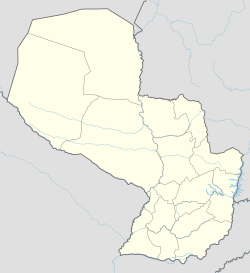Carapeguá
| Carapeguá | |
|---|---|
| Coordinates: 25°46′8.32″S 57°14′49.23″W / 25.7689778°S 57.2470083°WCoordinates: 25°46′8.32″S 57°14′49.23″W / 25.7689778°S 57.2470083°W | |
| Country | Paraguay |
| Department | Paraguarí |
| Founded | May 14, 1725 |
| Founded by | Martín de Barúa |
| Government | |
| • Intendente Municipal | Isabelino Silva |
| Area | |
| • Total | 435 km2 (168 sq mi) |
| Population | |
| • Total | 32,939 |
| • Density | 76/km2 (200/sq mi) |
| Postal code | 4240 |
| Area code(s) | (595) (532) |
Carapeguá (Spanish pronunciation: [kaɾapeˈɣwa], Guaraní: Karapegua) is a city and distrito of the Paraguarí Department, Paraguay, located 84 km from Asunción.
Settled by the Caañabé river and over the Route 1 "Mariscal Francisco Solano López", the Carapeguá district is located near the legendary Ypoá lake.
It is also known as the "Caañabé's Pearl".
This district has an area of 435 square kilometers, populated by approximately 32,939 inhabitants and with a population density of 75,72 inhabitants per square kilometer.
Carapeguá is known as the capital of the poyvi (the Guaraní word for "thread") because of its fine artisan production in objects made of threads like blankets, ponchos, sheets, hammocks and others. They are made with a technique popularly called "poyvi" in which old looms are used.
The inhabitants are dedicated to agricultural and cattle activities, and also to the cultivation of sugar-cane. In cattle production, they stock-breed cows, sheep and horses. In agricultural production they cultivate sugar cane, corn, cotton and manioc.
There exists a sugar mill and factories of sausages and tanning.
The main asphalted road is the Route 1 "Mariscal Francisco Solano López", that connects the district with Asunción and other locations of the department and the country.
Carapeguá is the most populated district of the Paraguarí Department. It has a total population of 32,939 inhabitants, being 16,903 males and 16,036 females.
Through this district flows the streams Caañabé and Aguai'hy-mí. In the western side of this district is the Ypoa estuary.
82.09% of the population is settled on the rural zone. 82.78% of the total houses correspond to the rural sector.
The main social-demographic indicators in the district says:
Population with unsatisfied basic needs in:
...
Wikipedia

